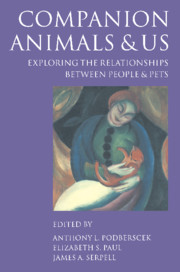Book contents
16 - Veterinary dilemmas: ambiguity and ambivalence in human–animal interaction
from Part IV - Welfare and ethics
Summary
INTRODUCTION
The relationship between humans and domesticated animals is replete with contradictions. It can be characterized by both intimacy and exploitation. Our conduct towards other animals is often seen in very black and white terms: some specieswe keep and use for food; upon others we lavish affection. In reality, however, the borders are rather more nebulous. While dogs are commonly kept and cherished as pets, they may also be severely maltreated and abandoned by their owners, or employed for sporting or scientific research. Similarly, an animal destined for the dinner plate may receive a great deal of respect, care and affection throughout its lifetime, and will not be treated at all as if itwere merely an animate unit of production. We must therefore avoid making sweeping statements about the relationship between ourselves and other animals. One dog owner may dote upon his dachshund, another may beat his. As Arluke and Sanders (1996: 4) have pointed out, ‘one of the most glaring consistencies’ in our interactions with other animals ‘is inconsistency’. It is largely for this reason that we should be cautious when referring to the small domesticated animals in our homes and gardens as ‘companion animals’. Frequently, this descriptor will fit the bill, but not always.
The human–animal relationship can thus be seen as ambiguous and ambivalent. Both the manner in which we perceive animals and the way in which we treat them show the contradictory nature of this relationship. However, this chapter is not specifically concerned with unravelling the contradictions inherent in the human–animal relationship. Instead, it will explore these disparities in terms of how other animals are treated in everyday life. The ambiguity and ambivalence that typically characterize our relationship with domesticated animals are most clearly reflected in settings in which human–animal interactions play a central role. Although, in recent years, the relationship between humans and other animals has received increasing attention within the social sciences, only a few authors have explicitly drawn attention to the ambiguities that pervade everyday human–animal interactions. For example, Wieder (1980), Lynch (1988) and Arluke (1988) discuss ambivalence towards animals within experimental laboratory settings. Similarly, Sanders (1995a) highlights the ambivalent nature of guide dog trainers’ relationships with their canine pupils. However, perhaps the best settings within which ambiguity and ambivalence in the human–animal relationship can routinely be observed are those involving veterinarians.
- Type
- Chapter
- Information
- Companion Animals and UsExploring the relationships between people and pets, pp. 292 - 312Publisher: Cambridge University PressPrint publication year: 2000



